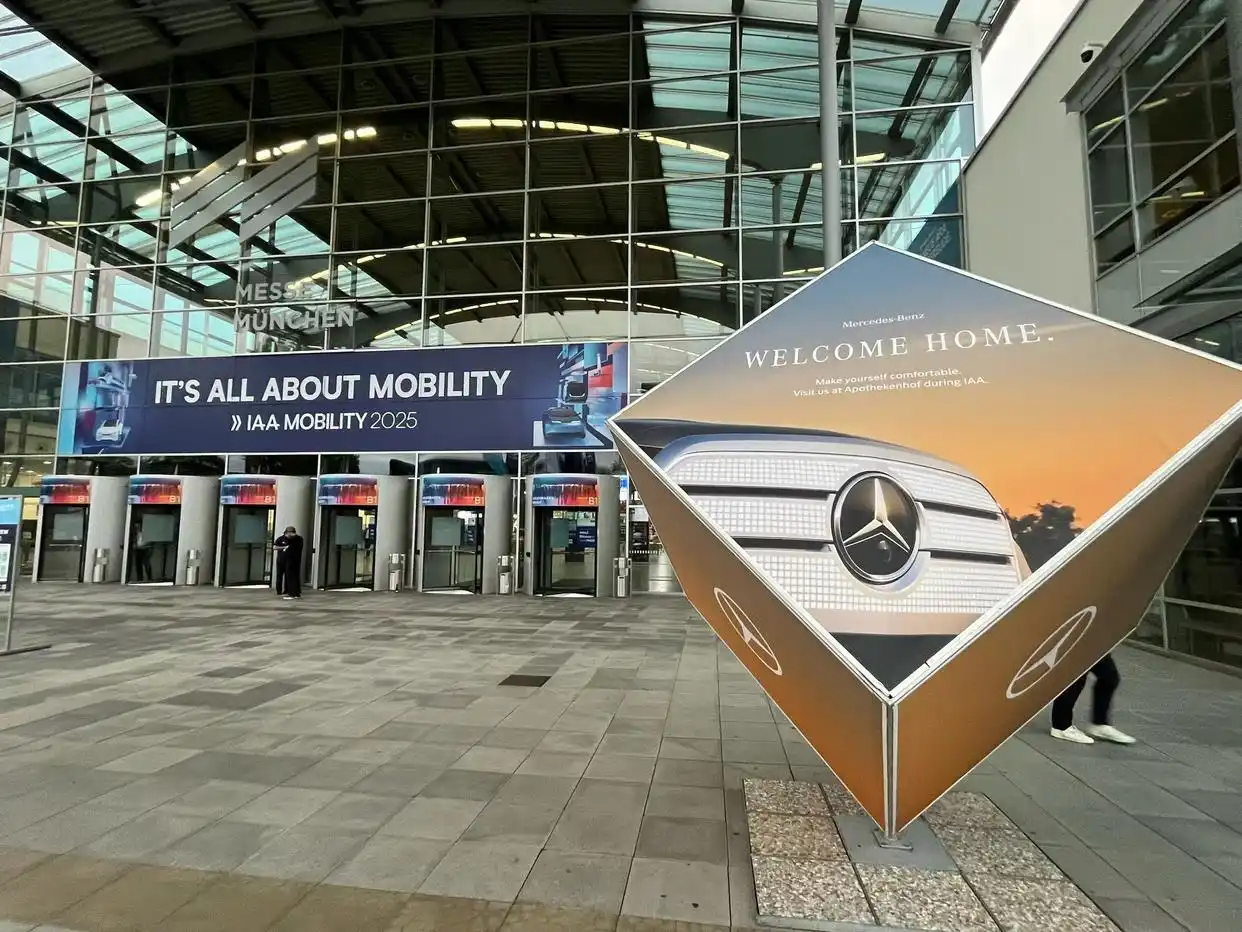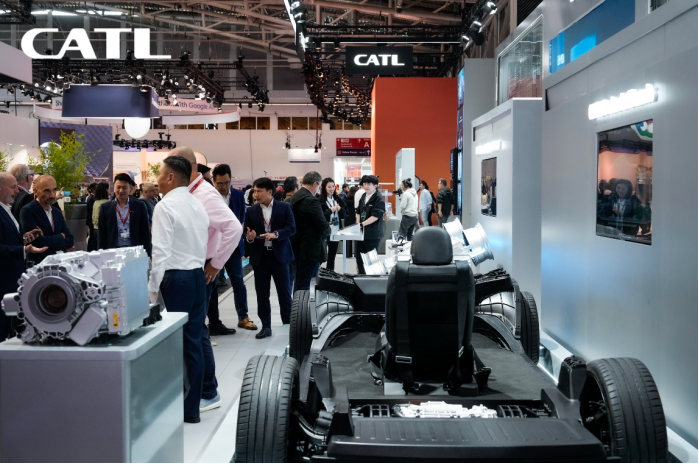
In September 2025, the Munich Motor Show (IAA Mobility), 128 years old, saw its biggest Chinese turnout ever—over 100 Chinese automakers and suppliers took up a full third of the show. That’s a first in the history of IAA.
From CATL’s carbon-free batteries to XPeng’s flying car, from BYD’s super charging to Horizon’s self-driving tech—Chinese companies are turning heads with innovation, not just size. This isn’t just a show of strength—it’s a new game. Together, they’re moving beyond exporting products to building real presence overseas.
Differentiation of exhibition models reflect update logic of car industries
Munich is different from Chinese auto shows. Back home, shows are huge—over 200,000 sqm—and all about sales numbers and signing deals. Munich is smaller, but it’s where global strategies get revealed.


Even in the heartland of luxury cars, Chinese brands didn’t play it safe. They brought their best stuff—like Leapmotor’s LAFA5, Avatr’s new concept car, and Deepal’s S05. It’s proof: Chinese brands are now competing on tech, not just price.
It wasn’t like the auto shows in China, where big brand stands steal the show. In Munich’s B1 hall, CATL and Horizon had booths side-by-side. XPeng’s flying car concept was displayed near Mercedes’ electric GLC. That vibe—where automakers and suppliers share the spotlight—shows how closely China’s auto industry works together.
This time in Munich, Chinese companies didn’t just show cars—they showed tech packages. Behind BYD’s super-fast charging, for example, you see CATL’s batteries and Huawei’s cooling systems. Leapmotor’s European model B10 runs on Horizon Robotics’ chip and Suteng Juchuang’s lidar.


By teaming up—OEMs and suppliers together—Chinese companies are making it easier and cheaper for European automakers to adopt their tech. And Chinese standards are going global. In fact, at this year’s show, Chinese firms held 32% of the patents in key areas like electric drives and smart cockpits—beating European companies for the first time.
Their ambition goes beyond tech—it’s about building complete ecosystems. While expanding its store network in Germany, Leapmotor is also working with Stellantis on battery recycling. That kind of local loop—making, supporting, and servicing—is helping change the image of Chinese products from “cheap” to “competitive.” In fact, in July 2025, Chinese EVs reached a 5.3% market share in Europe—holding above 5% for three months straight.
You can also tell Chinese automakers see Munich differently. Back home, auto shows are about selling cars. But in Munich, they’re launching global strategies. BYD announced its Hungary factory is opening this year—avoiding EU tariffs and tuning cars for Europeans. CATL unveiled new batteries designed for European roads and weather, and broke ground on a factory in Spain—completing its European triangle with Germany and Hungary. For Chinese companies, Munich isn’t a sales event—it’s a global stage.
The global competition behind the strategic spectacle
The Munich show felt like a battle over who leads the future of cars. When Chinese suppliers help develop BMW’s smart platform, or when Audi uses Huawei’s self-driving system, it’s obvious: the old tech barriers are falling. Chinese companies are gaining a real say in core technology.
Instead of just exporting, Chinese brands are now building locally. Leapmotor has 109 stores in Germany already and just launched the Lafa5 and B10 in Europe—priced around €30,000 to appeal to everyday buyers. Changan is planning a factory in Europe, and BYD already has a sales network there. It’s clear: China’s auto industry is moving from “made in China” to “made in Europe.”
This shift isn’t just good for getting around tariffs—it also helps them respond faster to what local customers want. XPeng, for example, just opened its first R&D center in Europe to adapt its self-driving systems to local roads. Their goal? To deliver smart driving that actually works everywhere by 2026. This “global tech, local tweaks” model is catching on. In fact, by 2025, Chinese automakers had already invested over €20 billion in European operations—covering everything from batteries to assembly.
Chinese exhibitors also made a point to highlight their “European side.” CATL talked up its “In Europe, for Europe” strategy. BYD showed off recycling tech that meets EU eco-standards—directly responding to Europe’s focus on sustainability. Being able to innovate while staying compliant is letting Chinese firms adapt without compromising on quality.


We’re also seeing a power shift in the auto supply chain. European giants like Bosch and Continental used to call the shots, but now Chinese suppliers are stepping up. Take Horizon Robotics teaming up with European brands on R&D, or CATL and Stellantis building factories together. Chinese companies are no longer just following orders—they’re helping design the products. And they’re proving that Chinese tech is safe and reliable. That’s helping change old stereotypes in the West.
At this year’s Munich show, Chinese companies weren’t just displaying products—they were demonstrating how China’s auto industry is reshaping the global value chain. But winning this race isn’t just about who has the best tech or the biggest scale. It’s about who can collaborate more openly and win trust across different cultures.
From taking up one-third of the booth space to showcasing the entire supply chain, from launching new tech to announcing local strategies—Chinese automakers are showing the world that the center of automotive innovation is moving east. The message from Munich is loud and clear: the days of just shipping finished cars abroad are over. Now, it’s about sharing their tech, making cars locally, and building a whole ecosystem abroad. This new approach is becoming China’s way of going global.

 Room 1104,Block B,JingBan Building,6 Middle Beisanhuan Road,Xicheng District,Beijing
Room 1104,Block B,JingBan Building,6 Middle Beisanhuan Road,Xicheng District,Beijing
 (8610)62383600
(8610)62383600
 quanqixiang@carresearch.cn
quanqixiang@carresearch.cn
 京公网安备:11010202007638号|京ICP备17032593号-2|Report illegal and bad information:010-65993545-8019 jubao@carresearch.com
京公网安备:11010202007638号|京ICP备17032593号-2|Report illegal and bad information:010-65993545-8019 jubao@carresearch.com
Legal support:Beijing Yingke Law Firm|All rights reserved, DO NOT reproduce without permission